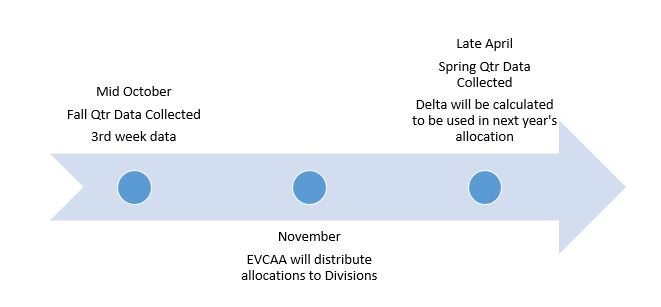Budget and Financial Management
The Budget and Financial Unit is responsible for managing the Academic Affairs operating budget which includes the allocation of permanent and temporary funds from a variety of funding sources. In addition, this unit oversees budget planning and allocation processes including those associated with the Program Review Committee (PRC) and its various subcommittees.
The Division Support model was created to standardize the metrics in which resources are calculated. In line with our efforts to ensure academic excellence, we provide our divisions with the resources necessary to accomplish our mission. The model identifies the general components needed to run an average department and division (e.g. HR, Finance Manager, IT Support, Grad Advisor, etc.). The calculations are then determined by the actual variables per department and division.
Excel
PDF
The Graduate Student Growth and Excellence Initiative Model was created to support the initiative to expand our non-resident enrollment. Through our Graduate Student Growth and Excellence Initiative, we are expanding our Ph.D. population, enhancing opportunities for our principal investigators to recruit the world’s best graduate students and increasing average net stipends paid across all divisions and departments. The model looks at first, second, and third-year non-resident enrollments in doctoral and MFA programs under Academic Affairs. Allocates 90% of the non-resident supplemental tuition back to the departments for these students while also showing the breakdown of the minimum quarterly return to faculty.

The Master’s Growth Incentive Program was created to provide incentive for the growth of master’s level students and boost opportunities for revenue growth and to heighten our contribution to the public. The MGIP model provides a budget structure that supports the growth of students seeking master’s degrees by directly returning some of the tuition back to departments, divisions and fellowships.
The TEMP FTE model was created to standardize and expedite the way TEMP FTE allocations are calculated and transferred from the EVCAA office to the divisions/departments. The model uses faculty FTE & quarterly course count to calculate the approximate amount of lecturers needed for departments to cover the Unmet Course Load.
The Academic Teaching Assistant Allocation model was created to standardize and expedite the way TA allocations are calculated and transfer from the EVCAA’s office to the divisions/departments. The TA Allocation model helps ensure that students/faculty receive the proper amount of guidance and have the necessary support per course. The model uses permanent & temporary faculty FTE and quarterly enrollments to calculate the approximate amount of TAs needed based on on recommended class size per faculty.
In an effort to assist divisions/departments with financial analysis, we created the Net Operating Report. With the implementation of the Simplified Operating Funds Initiative (SOFI) and the new use of program hierarchy, this report was developed to highlight funds and analyze current revenue/expenses within the divisions/departments. The report looks at Core Funds broken down by either Division or Departments. It shows the breakdown of Operating Budgets, Expenses and available balances broken down by program codes.
